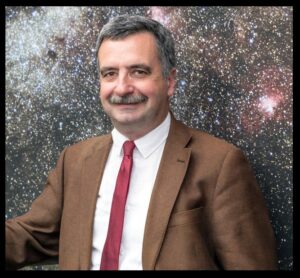I am happy to re-introduce to readers of Sacred Space Astronomy to guest blogger Fernando Comerón. He is an astronomer with the European Southern Observatory. He previously wrote about using one of the world’s best telescopes at ESO (click here for that post). This new post is about discovering a star.
Here Fernando describes the process of making a discovery in astronomy. But he also describes something else. He describes the excitement of discovery—of being one of only two people to know something, even if maybe it is, as he says, something most people might not care much about.
Fernando Comerón, 9 Sept 2019
Please have a look at these two images, of two nebulae that may be well known to you.
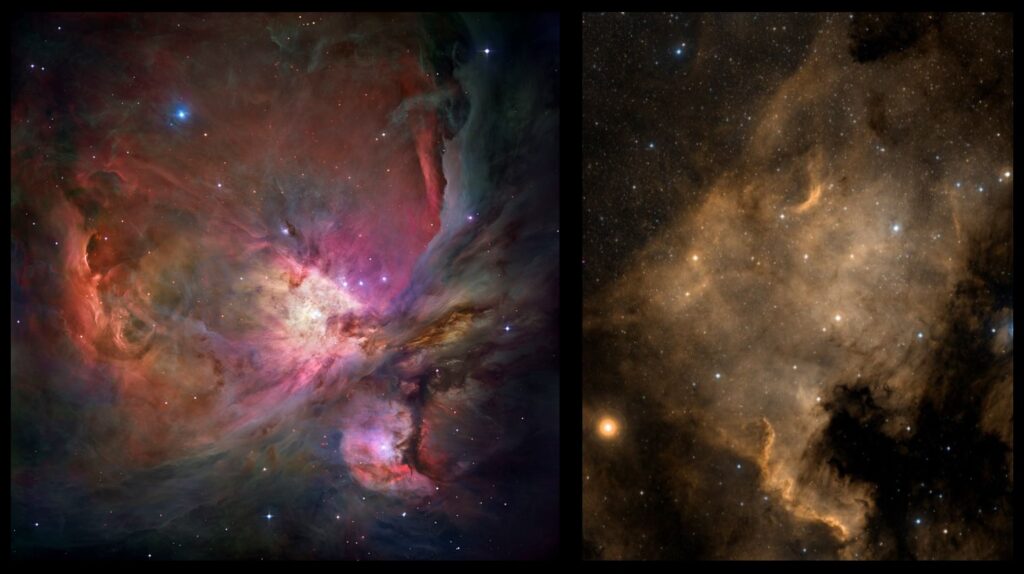 Left: The Orion nebula (credit: Hubble Space Telescope). Right: The North America Nebula (credit: Digitized Sky Survey 2)
Left: The Orion nebula (credit: Hubble Space Telescope). Right: The North America Nebula (credit: Digitized Sky Survey 2)The one on the left is the Orion Nebula, and the right one is the North America nebula. In astrophysical terms, both nebulae are what astronomers call “HII regions”. “HII” means that they are mainly composed of ionized hydrogen (H being Hydrogen). This is a plasma in which the electrons in the hydrogen atoms have been split from the protons of their nuclei and let free. Occasionally the electrons are recaptured by other protons, and in doing so they lose energy. This is radiated in the form of light at characteristic wavelengths or colors, producing the so-called spectral lines.
The ionization (that is, the split between the electron and the proton) happens when the electron absorbs a photon of ultraviolet light, which has enough energy to free the negatively charged electron from the electric attraction caused by the positively charged proton. Thus, to have a big HII region like the Orion or the North America nebulae we need to have lots of ultraviolet photons to keep a huge volume of hydrogen gas ionized. And those ultraviolet photons are produced by very hot stars, with temperatures of a few tens of thousands of degrees Celsius, whose light is mostly emitted in the ultraviolet part of the electromagnetic spectrum. Young, hot stars are also the most massive and most luminous stars, so they are generally easy to see.
Let us look back at the two images above. Things look all right for the Orion Nebula: we can see near its center a tightly packed cluster of bright stars, called the Trapezium, which is easily visible with amateur telescopes. All the bright stars composing the Trapezium are also very hot, emitting vast amounts of ultraviolet light. So the picture is clear about the Orion Nebula: it is a vast cloud of gas, composed mostly of ionized hydrogen, and the bright stars of the Trapezium are the ones that keep the hydrogen ionized. Everything fits!
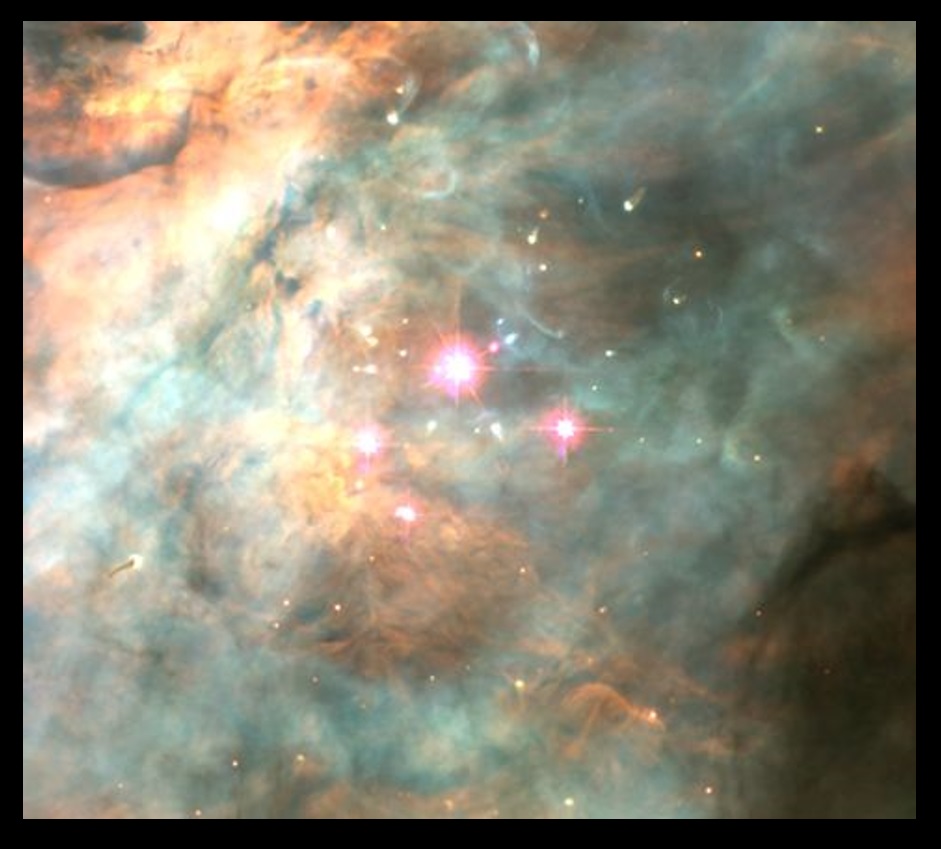 The bright stars forming the Trapezium asterism at the core of the Orion Nebula. The ultraviolet light of those stars keeps the gas of the nebula ionized and glowing. Credit: Hubble Space Telescope.
The bright stars forming the Trapezium asterism at the core of the Orion Nebula. The ultraviolet light of those stars keeps the gas of the nebula ionized and glowing. Credit: Hubble Space Telescope.But what about the North America nebula? Nothing like the Trapezium appears there. Where is the star, or the stars, that keeps the North America Nebula ionized? What keeps the North America Nebula glowing?
This was a mystery for many decades. One of the first astronomers to tackle it was Edwin Hubble, the astronomer after whom the Hubble Space Telescope is named. In 1922 he proposed that Deneb, the brightest star of the constellation Cygnus, the Swan, was the source of illumination of the nebula. Deneb is very bright, its white-blue color indicates a high temperature, and it appears very close to the North America Nebula in the sky, so it is an obvious suspect. However, further knowledge of stellar properties and of the spectrum of Deneb shows that its luminous output in the ultraviolet falls far below the intensity needed to ionize the North America Nebula. Now we also know that, although our line of sight toward the North America Nebula passes close to Deneb, they are not really physically related to each other.
The search for the star that causes the North America nebula glow went on in the decades following Hubble’s initial suggestion. A few hot and bright stars were found within its contours, but none of them producing enough ultraviolet light. Furthermore, other lines in the spectrum of the nebula indicated that the star responsible for the ionization had to produce “hard” ultraviolet radiation, this is, ultraviolet photons not only able to ionize hydrogen, but also to excite and ionize the electrons of other elements present in the nebula. This called for a star significantly hotter than those identified until then as possible candidates.
Let us look again at the image of the North America Nebula. Although it is the most obvious feature in the image, you can see that there is another large nebula to its right, which is called the Pelican Nebula, for obvious reasons when you look at its shape. It actually turns out that the North America and the Pelican nebulae are not two distinct nebulae, but a single one.
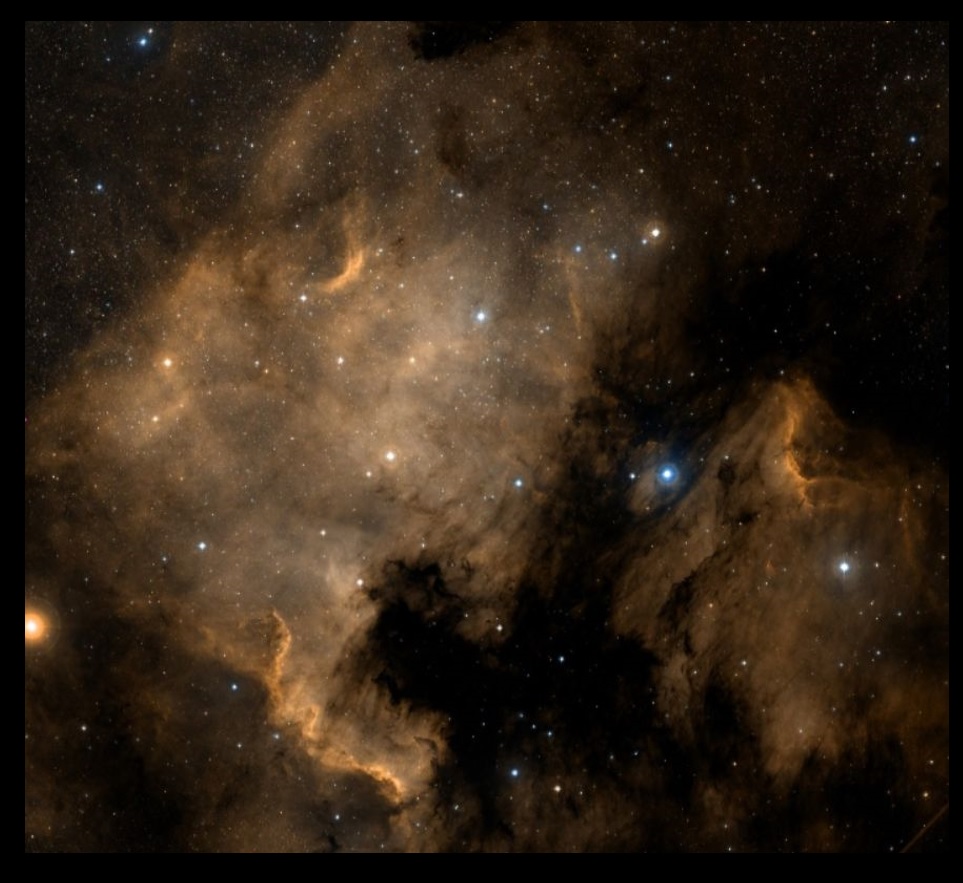 The North America nebula again, now with its companion, the Pelican Nebula, to its East (right). Credit: Digitized Sky Survey 2
The North America nebula again, now with its companion, the Pelican Nebula, to its East (right). Credit: Digitized Sky Survey 2The reason why the two nebulae appear separated is that there is a dark lane of light-absorbing dust along our line of sight, which happens to be projected against the bright backdrop of the glowing nebulae. In fact, it is the silhouette of this dark cloud (which is known as L935) that gives the North America and the Pelican nebulae their characteristic shapes—and hence their names. If thick enough, clouds of interstellar dust can be very good at hiding the stars behind them in the wavelengths to which our eyes are sensitive, which is why so many fewer stars are seen projected on L935 than on the North America and Pelican nebulae.
Now, again to the image of the North America and Pelican nebulae. If you look closely at their contours, you will see that some areas near their edges appear brighter than the inside. Those brightness enhancements are caused by the illumination of the surface of dense, but otherwise dark interstellar clouds that define the boundaries of the nebulae. And those bright rims at the edge of the nebulae appear to be facing toward a particular direction, as if they were illuminated by a definite source of light—which is exactly what is happening! The ridges are pointing the way toward the star that ionizes the North America and the Pelican nebulae.
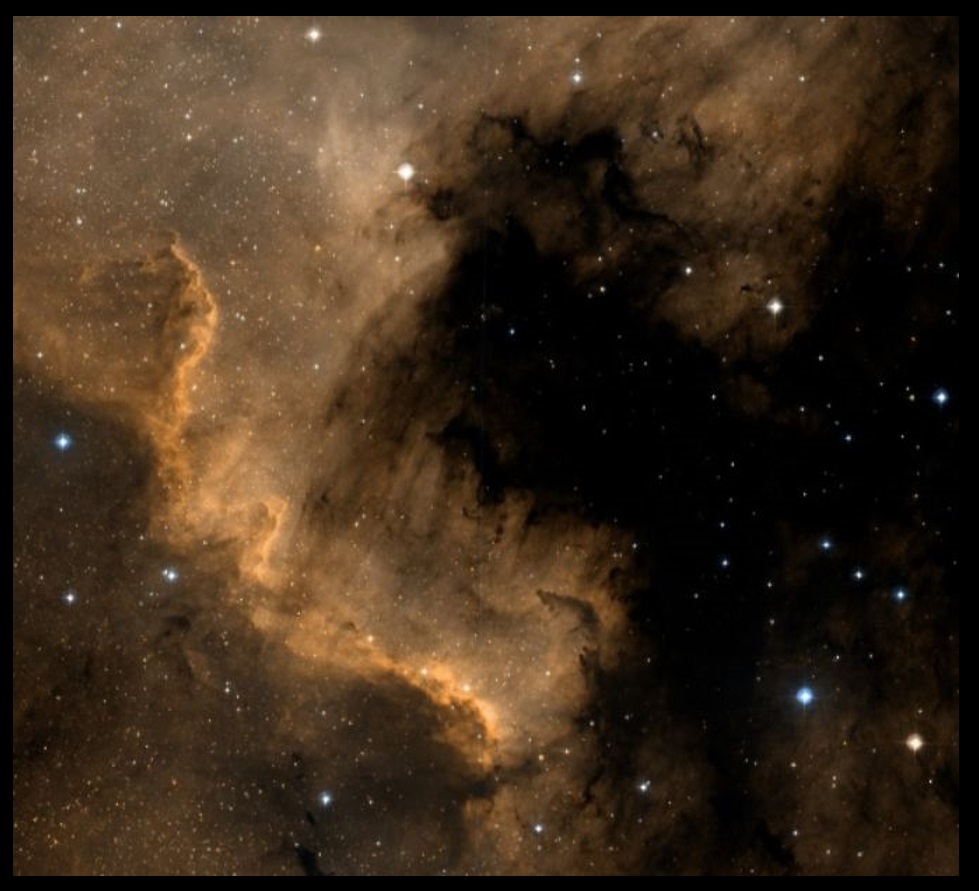 A closer look at the North America Nebula, now focusing on the “Gulf of Mexico” region. Notice the bright rims on the lower left quadrant, which look as if they were illuminated from the top right. This is actually what is happening, and the illumination pattern tells us in which direction we should look for the “hidden” source of light. Credit: Digitized Sky Survey 2
A closer look at the North America Nebula, now focusing on the “Gulf of Mexico” region. Notice the bright rims on the lower left quadrant, which look as if they were illuminated from the top right. This is actually what is happening, and the illumination pattern tells us in which direction we should look for the “hidden” source of light. Credit: Digitized Sky Survey 2Alas, the region of the sky where those bright rims suggest that we should look for the ionizing star lies inside the contours of L935. In other words, the star to which we must thank the beauty of the North America and Pelican nebulae is hidden from view by a cloud of interstellar dust!
Fortunately, interstellar dust is not fully opaque, and it is less and less opaque to red and then infrared light. Thus, it is not surprising that as infrared detectors improved and were increasingly used in astronomical observations, the search for the ionizing star of the North America and Pelican nebulae shifted to the infrared. And indeed, in 1980 several bright stars were found in infrared observations of the area where the ionizing star was expected.
This did not solve the puzzle, though. The vast majority of stars that are intrinsically bright in the infrared are actually old and comparatively “cool” stars, emitting almost negligible amounts of ultraviolet light, which completely rules them out as possible ionizing sources. So finding the presence of bright stars in the infrared was far from meaning that the search for the ionizing star of the North America and the Pelican nebulae was over.
Now, let me take you to one of my favorite places as a professional astronomer: Calar Alto Observatory, in the mountain range of Los Filabres, in Southern Spain. I happened to be at Calar Alto in early 2004, together with my colleague and friend Anna Pasquali, carrying out a project with a 2.2 meter telescope for which we had got several nights allocated, using an infrared camera and spectrograph, appropriately called MAGIC (a rather contorted acronym for MAx-Planck General-purpose Infrared Camera, as it had been built at the Max Planck Institute for Astronomy in Heidelberg, Germany). After a first few cloudless nights with a flawless telescope and instrument, we came to the realization that everything was going so well that that we would probably have observing time left after finishing the program!
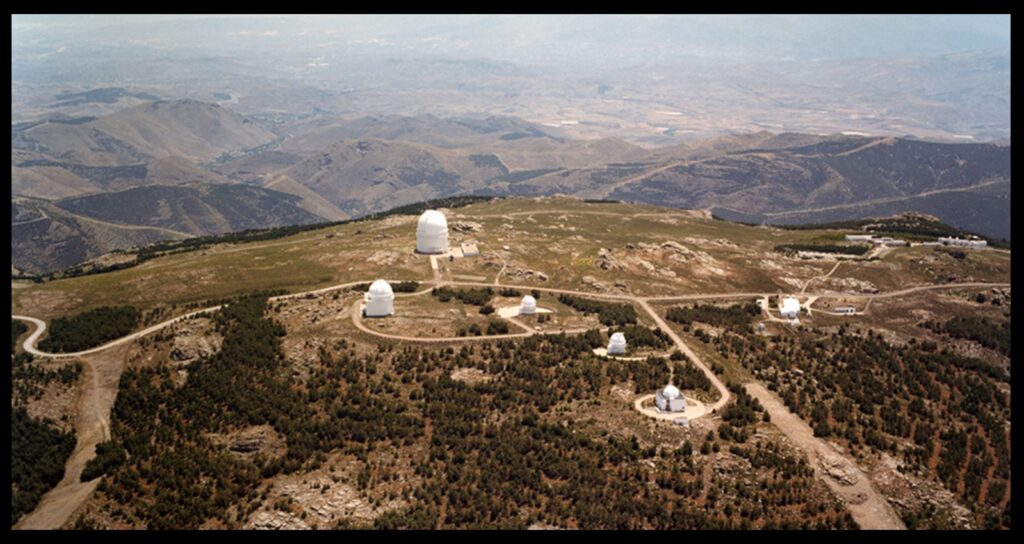 An aerial view of Calar Alto observatory, located at 2,100 meters altitude, in the province of Almería in Andalucía, Southern Spain. The biggest dome hosts a 3.5 meter telescope, the largest optical telescope in continental Western Europe. The 2.2 meter telescope with which we did the work described here is inside the leftmost dome.
An aerial view of Calar Alto observatory, located at 2,100 meters altitude, in the province of Almería in Andalucía, Southern Spain. The biggest dome hosts a 3.5 meter telescope, the largest optical telescope in continental Western Europe. The 2.2 meter telescope with which we did the work described here is inside the leftmost dome.The observations that we were carrying out for our project consisted of obtaining infrared spectra of stars suspected to be hot from their infrared colors, in a region of the sky not far from the North America and Pelican nebulae. The infrared colors of “hot” and “cold” stars are very similar but have a subtle difference, which cannot be blurred by the effect of absorption by interstellar dust. By looking at three different colors of infrared light, it is possible to discriminate between the hot and cold stars. Although this method works remarkably well, it is not foolproof, and one needs to obtain spectroscopy in order to confirm that the stars suspected to be hot from their colors really have the spectrum expected from a hot star. This was what we had set out to do in our observing run.
So there we were, Anna and I, wondering what to do at the end of our observing run after having obtained all the spectra that we intended to obtain, when I remembered to have read somewhere some time ago that the ionizing star of the North America Nebula had not yet been identified with certainty. And we realized that we had the tools, then and there, to try to solve that problem. Indeed, if our method was good at selecting hot stars among infrared sources, how about using it to select possible hot stars among all the infrared sources that appear in that darkened zone behind the L935 cloud, and then using our MAGIC spectrograph to confirm that they were indeed hot?
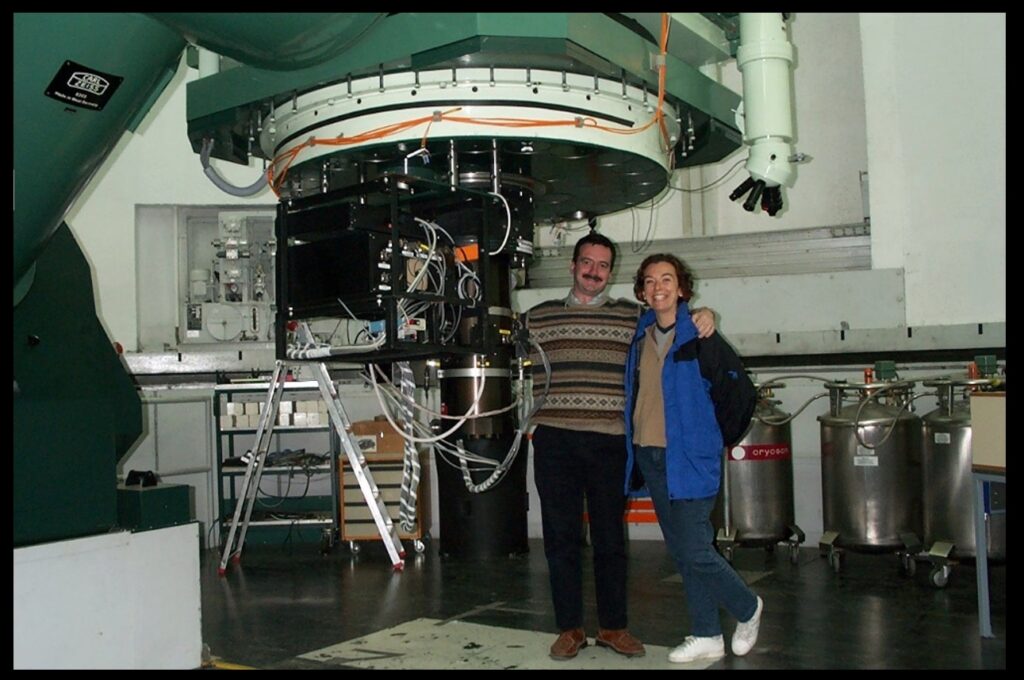 Observing at Calar Alto with my friend Anna Pasquali. The picture was taken around the time of our work on the North America Nebula, but here we appear with the 1.23 meter telescope, not the telescope that we used in that work.
Observing at Calar Alto with my friend Anna Pasquali. The picture was taken around the time of our work on the North America Nebula, but here we appear with the 1.23 meter telescope, not the telescope that we used in that work.And this is what we did. We obtained a list of 19 bright infrared stars in the area where the ionizing star was expected to be, and we started to obtain infrared spectra of them one after another, eagerly processing the observations in almost real time. We had been quite generous in defining the criteria of our search to make sure that the star we were after would not escape our selection, so it was no surprise to find that our spectra told us that we had selected mostly cold stars, clearly identified through their spectral features.
But not all the stars were cold: among the 19, three of them had spectra inconsistent with a cold temperature. One of them we could discard right away, as it was at most lightly obscured, so it could not lie behind L935. In the second one, which was number 11 in our list, we could see spectral lines typical of a star with a temperature of about 10,000 degrees C, which is hot but by far not as hot as needed to ionize a HII region, so it was not a very good candidate.
And then there was the third star, number 4 in our list, whose infrared spectrum was… featureless. This was a good thing, because very hot stars should appear featureless when observed with a spectrograph like MAGIC. But it was also tantalizing, because it is not possible to say just how hot a hot star is from a featureless spectrum. We were almost there. We had a single perfect candidate in star 4, but we needed the final piece of evidence. Ideally, we needed a spectrum of star number 4 in visible light.
Unfortunately, remember that star number 4 was behind a wall of obscuring dust. But looking at images of the area taken in visible light, we could see a faint star just at the location of our ideal candidate. As it turned out, the visible light of star number 4 was severely dimmed by the dust column along the line of sight, but not so much as to render it completely invisible. A visible-light spectrograph should be able to get its visible spectrum.
The next thing we did is something that astronomers can do only when they have been many times to a particular observatory and they have made good friends among the staff there. By that time in 2004 I had been observing at Calar Alto for the previous 15 years, so asked my friend Santos Pedraz, our support astronomer, if it would be possible to have MAGIC removed from the telescope the following morning, and to have the visible-light spectrograph CAFOS (an acronym for Calar Alto Faint Object Spectrograph) ready for the next night, which was also the last night of my observing run with Anna. Our request to carry out an unplanned change of instrument at the telescope was demanding in terms of observatory staff effort, but Calar Alto is lucky to have, then like now, a fabulous team of support astronomers and technical staff, and by the evening of the following night CAFOS was there ready to observe our star. The night was clear, and there we were ready to check how hot our star number 4 was.
We observed it, and also star number 11 (the latter only to be absolutely convinced that it had the visible spectrum of a star too cool to contribute to the ionization of the nebula in any meaningful quantity, as it indeed was). And then, once we obtained our set of spectra of star number 4, I went on anxiously to process it and see what it looked like.
Many of the features in the spectrum of star number 4 looked familiar, as in the past Anna and I had obtained many spectra of hot stars for other projects and knew their appearance almost by heart. But star number 4 had some features that we had not seen very often before: moderately strong lines of hydrogen, very weak lines of neutral helium… but comparatively strong lines of ionized helium! In other words, star number 4 was not only hot: it was very hot. It was just as hot as it needed to be in order to account for the spectrum of the North America and the Pelican nebulae, it was at the right location, and it was the only very hot star at that location. We had found it!
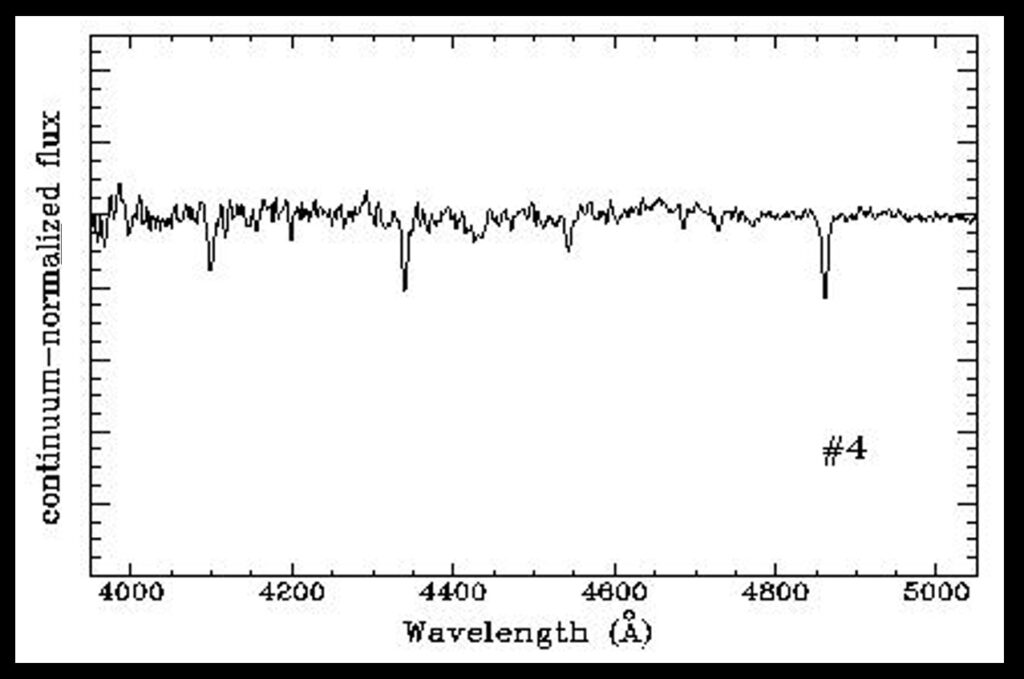 The spectrum that showed us that we had solved the mystery of the star that illuminates the North America Nebula. The three most prominent dips are absorption lines caused by hydrogen in the atmosphere of the star, but the subtle detail that shows that we had found it is the line seen at 4543 Angstrom, which corresponds to ionized helium. There is a barely visible line to its left, caused by neutral helium. The spectrum shows that helium in the atmosphere of this star is almost completely ionized, which tells us that the temperature of the star is very hot, above 40,000 degrees C. Exactly what we were looking for!
The spectrum that showed us that we had solved the mystery of the star that illuminates the North America Nebula. The three most prominent dips are absorption lines caused by hydrogen in the atmosphere of the star, but the subtle detail that shows that we had found it is the line seen at 4543 Angstrom, which corresponds to ionized helium. There is a barely visible line to its left, caused by neutral helium. The spectrum shows that helium in the atmosphere of this star is almost completely ionized, which tells us that the temperature of the star is very hot, above 40,000 degrees C. Exactly what we were looking for!And so our observing run ended. That morning, after finishing all the observations, I went to bed knowing that the mystery of the ionizing star of the North America and the Pelican nebulae had been finally solved—and at that point only Anna and I knew. It was a very gratifying feeling for an astronomer, even if nobody else in the world would care!
If you wish to know all the technical details about the observations and the results, you can read the article where we reported the discovery in the journal Astronomy and Astrophysics: Comerón, F., Pasquali, A.: 2005, “The ionizing star of the North America and Pelican nebulae”. But this is the first time that the story behind the discovery has been written, so only the readers of Sacred Space Astronomy know how the ionizing star of the North America Nebula was discovered.
 Here it is! The reddish, but otherwise unimpressive star indicated by the arrow is star number 4, the very hot star responsible for the beautiful display of light of the North America Nebula. Both its faintness and its reddish color are due to the obscuration caused by the interstellar cloud in front of it.
Here it is! The reddish, but otherwise unimpressive star indicated by the arrow is star number 4, the very hot star responsible for the beautiful display of light of the North America Nebula. Both its faintness and its reddish color are due to the obscuration caused by the interstellar cloud in front of it.
